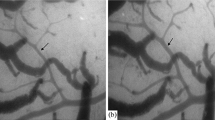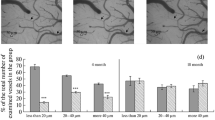Abstract
Changes in the contribution of intermediate conductance Ca2+-activated potassium channels (IKCa) to basal tone maintenance and acetylcholine (ACh)-mediated dilation of pial arteries after global cerebral ischemia (“2VO + hypo” model) were studied in 18-month-old Sprague–Dawley rats. Sham-operated rats served as a control. Vascular examination was performed 7, 14 and 21 days after ischemia/reperfusion (I/R) using intravital microphotography. Changes in the contribution of IKCa channels to basal tone were assessed by the number of pial arteries constricted in response to the IKCa channel blocker clotrimazole (10–7 M, 5 min). Changes in the contribution of IKCa channels to vascular dilation was evaluated by comparing the number and degree of pial artery dilatations in response to ACh (10–7 M, 8 min) before and after clotrimazole application. It was found that I/R leads to a decrease in the number of vascular dilatations in response to ACh, which persists over the first 14 days after ischemic exposure. During this post-ischemic period, the contribution of IKCa channels to pial artery tone and ACh-mediated dilatory response is also reduced. This phenomenon is already observed 7 days following I/R, while after 14 days, IKCa channels are practically no longer involved in the dilatory response of the pial arteries to ACh. By day 21 after I/R, all the above processes recover.




Similar content being viewed by others
REFERENCES
Davis CM, Siler DA, Alkayed NJ (2011) Endothelium-derived hyperpolarizing factor in the brain: influence of sex, vessel size and disease state. Womens Health (Lond) 7(3):293–303. https://doi.org/10.2217/whe.11.26
Ma J, Ma Y, Shuaib A, Winship IR (2020) Impaired collateral flow in pial arterioles of aged rats during ischemic stroke. Transl Stroke Res 11(2):243–253. https://doi.org/10.1007/s12975-019-00710-1
Yang Q, He GW, Underwood MJ, Yu CM (2016) Cellular and molecular mechanisms of endothelial ischemia/reperfusion injury: perspectives and implications for postischemic myocardial protection. AM J Transl Res 8(2):765–777.
Goto K, Ohtsubo T, Kitazono T (2018) Endothelium-dependent hyperpolarization (EDH) in hypertension: The role of endothelial ion channels. Int J Mol Sci 19(1): 315. https://doi.org/10.3390/ijms19010315
Tano JY, Gollasch M (2014) Calcium-activated potassium channels in ischemia reperfusion: a brief update. Front Physiol 5:381. https://doi.org/10.3389/fphys.2014.00381
Hakim MA, Chum PP, Buchholz JN, Behringer EJ (2020) Aging alters cerebrovascular endothelial GPCR and K+ channel function: divergent role of biological sex. J Gerontol A Biol Sci Med Sci 75(11):2064–2073. https://doi.org/10.1093/gerona/glz275
Garland CJ, Bagher P, Powell C, Ye X, Lemmey HAL, Borysova L, Dora KA (2017) Voltage-dependent Ca2+ entry into smooth muscle during contraction promotes endothelium-mediated feedback vasodilationin arterioles. Sci Signal 10: eall3806. https://doi.org/10.1126/scisignal.aal3806
Dong P, Zhao J, Zhang Y, Dong J, Zhang L, Li D, Li L, Zhang X, Yang B, Lei W (2014) Aging causes exacerbated ischemic brain injury and failure of sevoflurane post-conditioning: role of B-cell lymphoma-2. Neuroscience 275:2–11. https://doi.org/10.1016/j.neuroscience.2014.05.064
Tang Y, Wang L, Wang J, Lin X, Wang Y, Jin K, Yang GY (2016) Ischemia-induced angiogenesis is attenuated in aged rats. Aging Dis 7:326–335. https://doi.org/10.14336/AD.2015.1125
Gorshkova OP, Shuvaeva VN (2020) Age-related changes in the role of calcium activated potassium channels in acetylcholine mediated dilatation of pial arterial vessels in rats. J Evol Biochem Physiol 56(2):145–152. https://doi.org/10.1134/S0022093020020064
Izzo C, Carrizzo A, Alfano A, Virtuoso N, Capunzo M, Calabrese M, De Simone E, Sciarretta S, Frati G, Oliveti M, Damato A, Ambrosio m, De Caro F, Remondelli P, Vecchione C (2018) The impact of aging on cardio and cerebrovascular diseases. Int J Mol Sci 19(2):481. https://doi.org/10.3390/ijms19020481
Winship IR (2015) Cerebral collaterals and collateral therapeutics for acute ischemic stroke. Microcirculation 22(3):228–236. https://doi.org/10.1111/micc.12177
Van der Worp HB, Van Gijn J (2007) Acute ischemic stroke. New England J Med 357(6): 572–579. https://doi.org/10.1056/NEJMcp072057
Lensman M, Korzhevskii D, Mourovets VO, Kostkin V, Izvarina N, Perasso L, Gandolfo C, Otellin V, Polenov S, Balestrino M (2006) Intracerebroventricular administration of creatine protects against damage by global cerebral ischemia in rat. Brain Res 1114 (1): 187–194. https://doi.org/10.1016/j.brainres.2006.06.103
Behringer EJ, Hakim MA (2019) Functional interaction among KCa and TRP channels for cardiovascular physiology: modern perspectives on aging and chronic disease. Int J Mol Sci 20(6):1380. https://doi.org/10.3390/ijms20061380
Cipolla MJ, Smith J, Kohlmeyer MM, Godfrey JA (2009) SKCa and IKCa channels, myogenic tone, and vasodilator responses in middle cerebral arteries and parenchymal arterioles: effect of ischemia and reperfusion. Stroke 40(4):1451–1457. https://doi.org/10.1161/STROKEAHA.108.535435
Shimokawa H, Yasutake H, Fujii K, Owada MK, Nakaike R, Fukumoto Y, Takayanagi T, Nagao T, Egashira K, Fujishima M, Takeshita A (1996) The importance of the hyperpolarizing mechanism increases as the vessel size decreases in endothelium-dependent relaxations in rat mesenteric circulation. J Cardiovasc Pharmacol 28(5):703–711. https://doi.org/10.1097/00005344-199611000-00014.
Gorshkova OP, Shuvaeva VN, Lentsman MV, Artemyeva AI (2016) Postischemic changes in the vasomotor function of the endothelium. Modern Probl Sci and Educat 5:1. http://science-education.ru/ru/article/view?id=25270 (accessed: 09.01.2022).
Dabertrand F, Nelson MT, Brayden JE (2012) Acidosis dilates brain parenchymal arterioles by conversion of calcium waves to sparks to activate BK channels. Circ Res 110(2):285–294 https://doi.org/10.1161/CIRCRESAHA.111.258145
Li Y, Lapina N, Weinzierl N, Schilling L (2018) Enhancement of bradykinin-induced relaxation by focal brain ischemia in the rat middle cerebral artery: receptor expression upregulation and activation of multiple pathways. PLoS One 13(6):e0198553. https://doi.org/10.1371/journal.pone.0198553
Marrelli SP (2002) Altered endothelial Ca2+ regulation after ischemia/reperfusion produces potentiated endothelium-derived hyperpolarizing factor-mediated dilations. Stroke 33(9):2285–2291. https://doi.org/10.1161/01.str.0000027439.61501.39
Palomares SM, Cipolla MJ (2011) Vascular protection following cerebral ischemia and reperfusion. J Neurol Neurophysiol 2011:1–12. https://doi.org/10.4172/2155-9562.s1-004
Wulff H, Gutman GA, Cahalan MD, Chandy KG (2001) Delineation of the clotrimazole/TRAM-34 binding site on the intermediate conductance calcium-activated potassium channel, IKCa1. J Biol Chem 276:32040–32045. https://doi.org/10.1074/jbc.m105231200
Cipolla MJ, Bullinger LV (2008) Reactivity of brain parenchymal arterioles after ischemia and reperfusion. Microcirculation 15(6):495–501. https://doi.org/10.1080/10739680801986742
Kalogeris T, Baines CP, Krenz M, Korthuis RJ (2016) Ischemia/reperfusion. Compr Physiol 7(1):113–170. https://doi.org/10.1002/cphy.c160006
Sonkusare SK, Dalsgaard T, Bonev AD, Nelson MT (2016) Inward rectifier potassium (Kir2.1) channels as end-stage boosters of endothelium-dependent vasodilators. J Physiol 594(12): 3271–3285. https://doi.org/10.1113/JP271652
Dora KA, Gallagher NT, McNeish A, Garland CJ (2008) Modulation of endothelial cell KCa3.1 channels during endothelium-derived hyperpolarizing factor signaling in mesenteric resistance arteries. Circ Res 102:1247–1255. https://doi.org/10.1161/CIRCRESAHA.108.172379
Mozaffari MS, Liu JY, Abebe W, Baban B (2013) Mechanisms of load dependency of myocardial ischemia reperfusion injury. Am J Cardiovasc Dis 3(4):180–196.
Behringer EJ, Shaw R.L, Westcott EB, Socha MJ, Segal SS (2013) Aging impairs electrical conduction along endothelium of resistance arteries through enhanced Ca2+-activated K+ channel activation. Arterioscler Thromb Vasc Biol 33(8): 1892–1901. https://doi.org/10.1161/ATVBAHA.113.301514
Funding
The study was supported by the State Program 47 GP “Scientific and Technological Development of the Russian Federation” (2019–2030), theme reg. no. 0134-2019-0001.
Author information
Authors and Affiliations
Contributions
Conceptualization and experimental design (O.P.G.); data collection (I.B.S.); data processing (O.P.G., I.B.S.); writing and editing a manuscript (O.P.G., I.B.S.).
Corresponding author
Ethics declarations
CONFLICT OF INTEREST
The authors declare that they have neither evident nor potential conflict of interest related to the publication of this article.
Additional information
Translated by A. Polyanovsky
Russian Text © The Author(s), 2022, published in Rossiiskii Fiziologicheskii Zhurnal imeni I.M. Sechenova, 2022, Vol. 108, No. 5, pp. 636–648https://doi.org/10.31857/S0869813922050065.
Rights and permissions
About this article
Cite this article
Gorshkova, O.P., Sokolova, I.B. Changes in the Сontribution of IKCa Сhannels to Tone Maintenanсe and Dilation of Pial Arteries in Aging Rats after Ischemia-Reperfusion. J Evol Biochem Phys 58, 815–824 (2022). https://doi.org/10.1134/S0022093022030152
Received:
Revised:
Accepted:
Published:
Issue Date:
DOI: https://doi.org/10.1134/S0022093022030152




